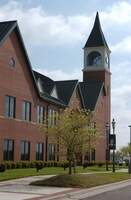33-36
ACT Score Range 33-36
Students who score in the range 33-36 are likely to know and to be able to do:
English
Students can determine whether a complex essay has accomplished a specific purpose. They consider the need for introductory sentences or transitions, basing their decisions on a complete understanding of both the logic and rhetorical effect of the paragraph and essay. They can add a phrase or sentence to accomplish a complex purpose, often expressed in terms of the main focus of the essay. They delete redundant material that involves subtle concepts or that is redundant in terms of the paragraph as a whole. These student work comfortably with long sentences and complex causal relationships within sentences, avoiding weak conjunctions between independent clauses and maintaining parallel structure between clauses. They can ensure that a verb agrees with its subject when a phrase or clause between the two suggests a different number for the verb. They can provide idiomatically and contextually appropriate prepositions following verbs in situations involving sophisticated language or ideas. They know how to use a colon to introduce an example or an elaboration.
Reading
Students can read closely and reason about even the most dense and complex passages. They can identify main ideas of passages and paragraphs, locate the important details and facts that support any idea or argument, and order sequences of events in complex passages. They make comparisons, conclusions, and generalizations that reveal a feeling for the subtleties in relationships between characters and ideas. They also have the ability to identify implied cause-effect relationships in complex passages, and can determine, even in situations where the language is quite figurative and the vocabulary is difficult, the meanings of context-dependent words or phrases in any passage. They read with critical understanding, evident in their ability to make complex generalizations about characters and situations by synthesizing information from different portions of the text. They are also able to identify and then generalize about an author's attitude or point of view toward his or her subject in virtually any passage. They can understand and generalize about portions of a complex literary narrative that use a range of literary devices.
Mathematics
Students can solve complex arithmetic problems involving percent of increase or decrease and problems requiring integration of several concept from pre-algebra and/or pre-geometry (e.g., comparing percentages or averages, using several ratios, and finding ratios in geometry settings). In probability , statistics, and data analysis, students can analyze and draw conclusions based on information from tables and graphs including graphs in the coordinate plane and exhibit knowledge of conditional and joint probability. In algebra, they can draw conclusions based on number of concepts, algebraic properties, and/or relationships between expressions and numbers; exhibit knowledge of logarithms and geometric sequences; can write an expression or equation that requires planning, solving, and/or manipulating to accurately model a situation; and can solve simple absolute value inequalities. In coordinate geometry, they can graph solutions to simple quadratic inequalities on the number line and identify characteristics of graphs in the coordinate plane based on a general equation such as y=ax2 + c or on a set of conditions. In geometry, they can draw conclusions based on a set of conditions; solve multi-step geometry problems that involve integrating concepts, planning, visualization, and/or making connections with other content areas (e.g., illustrating a scenario and then determining a solution path, and using algebraic representations for area); use scale factors to determine the magnitude of a size change; and compute the area of irregularly shaped regions that require planning or visualization. In trigonometry, they can use trigonometric concepts and basic identities to solve problems; exhibit knowledge of unit circle trigonometry; and can recognize graphs of basic trigonometric functions.
Science Reasoning
Students can compare and combine data from two data sets. They are also able to combine new, complex information with given data or other information. They understand precision and accuracy issues. When analyzing an experiment, these students can predict how modifying an experiment or study (adding a new trial or changing a variable) will affect the results. They can also identify new information that could be collected from a new experiment or by modifying an existing experiment. They can select a complex hypothesis, statement, prediction, generalization, or conclusion based on two or more data sets. They are able to determine whether given data or other information supports or contradicts a hypothesis or conclusion.
Used with permission of ACT from "ACT, Information for Life's Transitions, Standards for Transitions: Descriptions of the Skills and Knowledge Associated with PLAN and ACT Assessment Scores", c1998.

